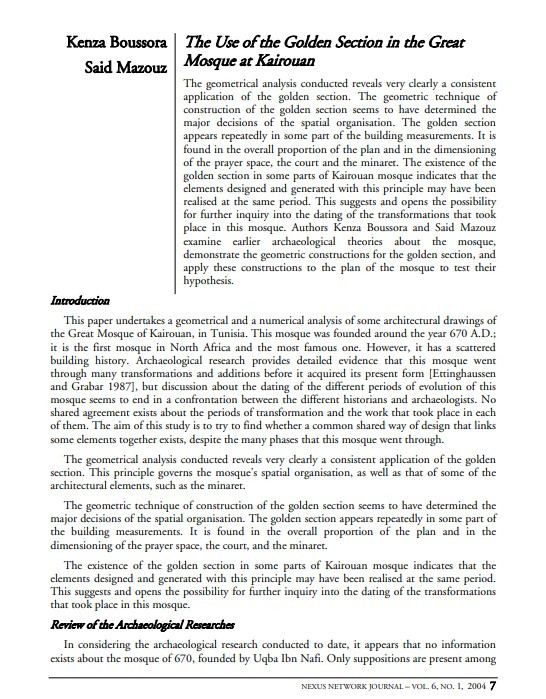
The Great Mosque of Kairouan is a mosque situated in the UNESCO World Heritage town of Kairouan, Tunisia. Established by the Arab general Uqba ibn Nafi in 670 at the founding of the city of Kairouan, the mosque is spread over a surface area of 9,000 square metres and it is one of the oldest places of worship in the Islamic world, as well as a model for all later mosques in the Maghreb.
The Great Mosque of Kairouan is one of the most impressive and largest Islamic monuments in North Africa; its perimeter is almost equal to 405 metres (1,328 feet). This space contains a hypostyle prayer hall, a marble-paved courtyard and a square minaret. In addition to its spiritual prestige, the Mosque of Uqba is one of the masterpieces of Islamic architecture, notable among other things for the first Islamic use of the horseshoe arch.
Under the Aghlabids (9th century), huge works gave the mosque its present aspect. The fame of the Mosque of Uqba and of the other holy sites at Kairouan helped the city to develop and repopulate increasingly. The university, consisting of scholars who taught in the mosque, was a centre of education both in Islamic thought and in the secular sciences. Its role can be compared to that of the University of Paris in the Middle Ages With the decline of the city of Kairouan from the mid-11th century, the centre of intellectual thought moved to the University of Ez-Zitouna in Tunisia.
Located in the north-east of the city of Kairouan, the mosque is in the intramural district of Houmat al-Jami (literally “area of the Great Mosque”). This location corresponded originally to the heart of the urban fabric of the city founded by Uqba ibn Nafi. However given the natural lay of the land crossed by several tributaries of the wadis, the urban development of the city spread southwards. Human factors including Hilalian’s invasions in 449 AH (1057 AD) led to the decline of the city and halted development. For all these reasons, the mosque which once occupies the centre of the median when first built in 670 is now on the eastern most quarter abutting the city walls.
The building is a vast slightly irregular quadrilateral covering some 9,000 m2. It is longer (127.60 meters) on the east side than the west (125.20 meters), and shorter on the north side (72.70 meters) then the south (78 meters). The main minaret is centred on the north.
From the outside, the Great Mosque of Kairouan is a fortress like building with its 1.90 meters thick massive ocher walls, a composite of well-worked stones with intervening courses of rubble stone and baked bricks. The corner towers measuring 4.25 meters on each side are buttressed with solid projecting supports. Structurally given the soft grounds subject to compaction, the buttressed towers added stability to the entire mosque. Despite the austere facades, the rhythmic patterns of buttresses and towering porches, some surmounted by cupolas, give the sanctuary a sense of striking sober grandeur.
Built on a rectangular plane 125 m long and 75 m wide, the building consists of a courtyard and a 137 m x 37 m portico entrance, divided into 17 straits and 8 bays. The encounter between the central strait and the bay along the wall of Qibla forms a square area in front of the mihrab. Above this square is a grooved dome attached to a carved stone crevice. These are decorated with shell and polyfoil rosette motifs inspired by the Umayyad repertoire. Numerous pillars and ancient capitals in the gallery surrounding the chapel and courtyard form the largest collection of Islamic monuments and museums in the Roman and Byzantine capitals. Despite the continuous restoration of the 8th and 9th centuries (14th and 15th AD), some beautiful beams remain on the wooden roof of the chapel. Dating to 3 AH / 9th century AD, it is decorated in a Greek style with spear-shaped fruits wrapped in symmetrical palm leaves.
The city of Kairouan in Tunisia has long been the oldest and most sacred city in Maghreb, an important meeting place for Arab and Islamic civilizations. The Grand Mosque, also known as the Okba Mosque, is the centre of the city’s heritage. Located at the intersection of 15 different roads between the mountains and the sea in the centre of the country, it is considered the fourth holy place in Islam after Mecca, Medina and Jerusalem. The structure is part of a vast complex and the mosque itself covers 9000 square meters.
Disclaimer : Mopsqpedia is a non-profit database. All images featured in the database are sourced from various references, publications, and websites related to mosque architecture. Mosqpedia does not claim ownership of any images unless explicitly stated. Images are provided solely for educational and bibliographic purposes. Mosqpedia disclaims any responsibility for copyright infringements related to the images displayed. Users are responsible for verifying copyright status and obtaining permission from original sources if they intend to reproduce, distribute, or use any image beyond fair use.
I agree to the terms outlined below:
You agree to upload and assign Mosqpedia Database the rights to use the content worldwide and in perpetuity across all current and future media platforms. Mosqpedia Database may edit, copy, adapt and translate your contribution.
The content will be distributed under the Creative Commons Attribution-Deed – Attribution-NonCommercial-NoDerivatives 4.0 International – Creative Commons
All data will be stored in line with data protection regulations.
I agree to the terms outlined below:
You agree to upload and assign Mosqpedia Database the rights to use the content worldwide and in perpetuity across all current and future media platforms. Mosqpedia Database may edit, copy, adapt and translate your contribution.
The content will be distributed under the Creative Commons Attribution-Deed – Attribution-NonCommercial-NoDerivatives 4.0 International – Creative Commons
All data will be stored in line with data protection regulations.